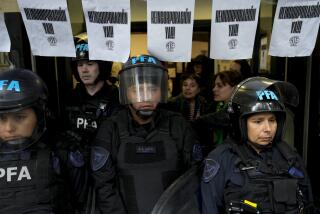Brazil, Argentina Grapple With Inflation
RIO DE JANEIRO — Like two alcoholics on the wagon, Brazil and Argentina seemed to be overcoming their common affliction: inflation. And who knows, cured of inflation, maybe they could soon be marching steadily side by side toward their shared goal of full economic development.
But once again, South America’s two biggest economies are in serious trouble as official anti-inflation programs lose credibility and authorities take emergency measures against relapsing into economic instability.
The Brazilian and Argentine struggles with inflation go back many years, but one of the worst moments in both countries came last March. The inflation rate for that month alone was 95% in Argentina and 84% in Brazil.
Presidents Fernando Collor de Mello, who had just taken office in Brazil, and Carlos Saul Menem of Argentina tightened the fiscal and monetary screws on their economies, following modified free-market policies. They were successful, at least, in staving off hyper-inflationary chaos.
In Brazil, the monthly inflation rate dropped to under 8% in May after a temporary price freeze, then leveled off at 12% to 13% a month. Officials predicted that by January it would be down to one digit and falling. When January ended, however, it was over 20% and rising.
“We are on the road to hyper-inflation,” warned Prof. Roberto Macedo of the University of Sao Paulo. Zelia Cardoso de Melo, Collor’s economy minister, was forced to freeze prices and salaries again last Thursday.
Cardoso announced that Brazil was “entering a new phase of stabilization, this one with much more optimistic prospects.” Brazilian experience has shown, however, that price-freezes will not control inflation on a sustained basis.
Argentina’s inflation fell sharply under Menem’s shock treatment, then further subsided to an encouraging 4.7% in December, the lowest monthly rate in three years. But upward surges in the dollar exchange rate during January signaled a deep lack of public confidence in President Menem’s economic policies and a probable return of double-digit monthly inflation.
Menem urgently replaced his economic team, shifting Harvard-educated Domingo Cavallo from foreign minister to economy minister. Still, few Argentines believed that Cavallo could stop prices from climbing at a considerably faster rate than the estimated 10% in January.
One problem is that the dollar exchange rate, which nearly doubled in less than two months, is widely used as a pricing index by Argentine businesses. Cavallo’s predecessor tried to control the dollar’s inflationary impact by keeping the exchange rate artificially low, but the tactic backfired in the end.
The main problem in both Argentina and Brazil is that other anti-inflation measures, tough as they may appear on paper, have not been administered convincingly.
Both the Menem and Collor administrations have emphasized efforts to curtail liquidity by keeping expansion of the money supply well below expected inflation. This hurts. It is recessionary and therefore unpopular, and it limits the government’s access to cash.
So both governments have broken their austerity vows at more than one point, turning on printing presses and letting new cash flow. Brazilian currency emissions in December, for example, expanded the money supply by 58%.
Also, both governments have been somewhat slow to reduce their size and operating costs, something that they both acknowledge is necessary to permanently conquer inflation.
It isn’t easy. Laying off government workers is problematic because they are protected by labor laws, by unions and by political influence. Cutting back on government services causes political and social problems in countries where those services often are deficient to begin with.
Menem, who took office in July, 1989, has privatized several government-run enterprises, including Aerolineas Argentinas and Entel, the telephone company. However, hints of corruption in the privatization process have damaged government credibility. In Brazil, Collor promised to privatize dozens of state companies, but the project has bogged down in the planning stage.
Both governments have embraced the theory that if they lower import barriers, foreign goods in their markets will help stimulate price competition, the most effective mechanism against inflation. In both countries, however, the market “opening” is planned as a gradual process.
Argentina and Brazil combined could be a formidable market by global standards. Argentina’s gross domestic product is in the range of $90 billion a year, while Brazil’s is about $330 billion, among the world’s 10 biggest. Together, they account for about half of the total Latin American GDP.
In 1990, the two countries agreed to form a common market by 1994, potentially a giant step toward the status of emerging economic power bloc--but one that will be nearly impossible to take unless both countries can stabilize their economies and currencies. And that looks like an arduous task for Presidents Menem and Collor as they begin new phases of treatment for the chronic inflation that troubles their neighboring countries.
More to Read
Sign up for Essential California
The most important California stories and recommendations in your inbox every morning.
You may occasionally receive promotional content from the Los Angeles Times.










